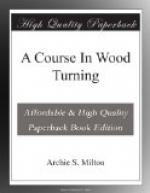The remaining 1/8” is then removed by taking very thin cuts (about 1/32”) holding the chisel as first stated. After each cut is made the end should be tested for squareness by holding the edge of the chisel over the end of the cylinder.
[Illustration: Fig. 8.]
This is an easy cut after it is mastered, but is one of the hardest to learn. Should the operator lose control of the tool and allow any part other than the point to touch the cylinder, a run or gashing of the wood will be caused.
In large cylinders where considerable stock has to be cut away in order to square the ends, time will be saved by sizing the ends down with the parting tool to within 1/8” of the desired line, leaving enough stock at the base of the cuts to still hold the cylinder rigid while cutting on the ends.
[Illustration: Fig. 9.]
For this operation hold the parting tool on the rest with the cutting edge parallel to the axis of the cylinder and the lower grind tangent to the cylinder. Lift the handle and force the cutting edge into the wood; at the same time push the chisel forward to keep it at the proper tangency.
7. Cutting off (small skew). Fig. 9.
After both ends have been squared cut away stock, at both ends, to leave just enough to hold the cylinder from separating from the waste ends.
With the chisel held in the right hand in the same position as in squaring the ends, and the fingers of the left hand around the stock to catch it, slowly force the point of the chisel into the stock at the live center end, until it is cut free and the cylinder stops in the operator’s hand. Too much pressure should not be used in this operation or it will cause the cylinder to twist off instead of being cut, and will leave a ragged hole in the end.
The dead center end, which has been scored heavily before cutting off at the live center, is then removed by holding the grind of the chisel flat on the end of the cylinder. The latter is revolved by hand until the stock is cut away.
Exercise A-I—2-a. Shoulder Cuts
1. Turn a cylinder to the largest diameter required.
2. Lay off measurements with rule and pencil.
3. With the gouge (where space permits) or the parting tool (in narrow spaces) rough out surplus stock, keeping 1/16” away from the lines indicating shoulders.
4. Caliper to the diameter of the second step.
5. The shoulders are cut down as described in “Squaring Ends, Step 6, Straight Cuts.”
6. The new diameter or step is then trued up with a skew chisel in the same manner as a cylinder; except that in nearing the shoulder the chisel is pushed up on the cylinder until the heel, which is the only part that can be worked into the corner, becomes the cutting point. Fig. 10. In very narrow steps it will be advisable to use the heel entirely as a cutting point.




